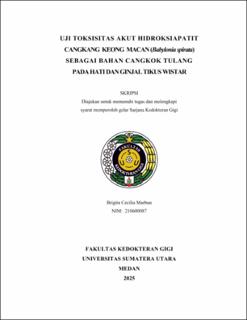Uji Toksisitas Akut Hidroksiapatit Cangkang Keong Macan (Babylonia spirata) Sebagai Bahan Cangkok Tulang Pada Hati dan Ginjal Tikus Wistar
Acute Toxicity of Hydroxyapatite from Tiger Snail Shells (Babylonia spirata) as Bone Graft Material in the Liver and Kidney of Wistar Rats

Date
2025Author
Marbun, Brigita Cecilia
Advisor(s)
Nasution, Aini Hariyani
Metadata
Show full item recordAbstract
Periodontal disease is one of the two most prevalent dental and oral health conditions worldwide. Bone grafting is a common surgical therapy for periodontal treatment, and hydroxyapatite (HA) is one of the most commonly used materials for this purpose. The uniqueness of this material lies in its chemical similarity to the mineral phaseof bone, providing excellent osteoconductive, osteointegrative, and biocompatible properties. One marine organism containing hydroxyapatite is the Shell of the Tiger Snail (Babylonia spirata). Any material or substance with potential medicinal properties must be scientifically proven to meet safety standards. One method for assessing the safety of materials with drug potential is oxicity testing. Toxicity can lead to changes in vital organs such as the liver and kidneys. The purpose of this study was to determine the acute toxicity of hydroxyapatite derived from Tiger Snail (Babylonia spirata) shells when used as a bone graft material, by assessing the LD50 value and its effects on the liver and kidneys of Wistar rats. This study was an experimental laboratory investigation with a post-test only control group design. The sample consisted of 30 healty female Wistar rats, aged 8-12 weeks. The results showed that the LD50 of hydroxyapatite from Tiger Snail (Babylonia spirata) shells exceeded 2000 mg/kg body weight (BW), as no rats died or exhibited signs of toxicity. There were no significant differences in body weight, liver weight, or kidney weight among the groups. SGOT levels at doses of 5, 50, and 300 mg/kg BW did not show siginificant differences, but at 2000 mg/kg BW, there was a significant increase, though still within normal limits. SGPT levels did not differ significantly across all groups, while creatinine levels increased significantly at 2000 mg/kg BW, but remained within normal limits. In conclusion, the LD50 value of hydroxyapatite derived from Tiger Snail (Babylonia spirata) shells exceeds 2000 mg/kg BW, classifying it as a relatively safe material that does not cause acute toxicity in the liver and kidneys of Wistar rats.
Collections
- Undergraduate Theses [1908]
